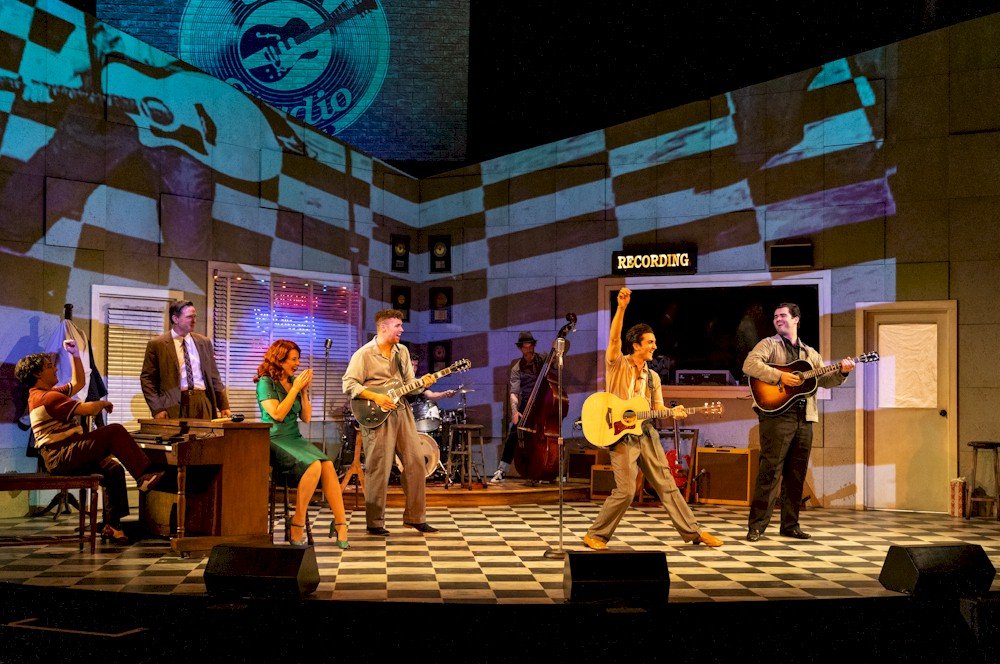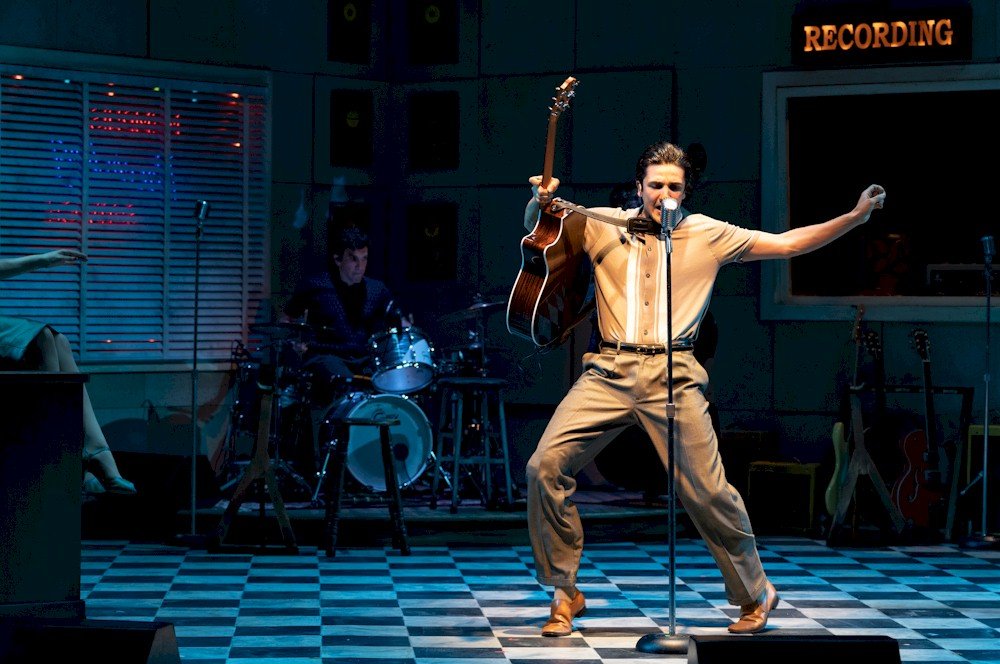Theatre review: Convincing performances of Elvis, Jerry Lee Lewis, and more in high-energy Million Dollar Quartet
At the Arts Club Granville Island Stage, rock and roll icons gather for an epic evening of retro hits
Projected video and an angular set give Million Dollar Quartet’s legendary Sun Records studio session added visual interest. Photo by Moonrider Productions
The Arts Club Theatre presents Million Dollar Quartet, held over at the Granville Island Stage until August 20
ELVIS IS BACK in the building. And he’s with Johnny Cash, Jerry Lee Lewis, and Carl Perkins!
If the idea of these four rock and roll icons having a jam session together seems too far-fetched, consider this: it actually did happen on December 4, 1956 in Memphis, Tennessee. Million Dollar Quartet, a Broadway jukebox musical, re-enacts this famed jam session and the events that unfolded. The Arts Club’s version of the Tony Award-winning musical is inventive and pays terrific tribute to the music legends, highlighted by high-energy, crowd-pleasing performances.
The story—seen through the eyes of Sam Phillips, owner of Sun Records—begins at a recording session Phillips has organized for Carl Perkins, where newcomer Jerry Lee Lewis has been invited to accompany Perkins on the piano. The underlying drama is that Johnny Cash will be arriving later, and Phillips is planning on presenting Cash with a three-year contract extension—a huge win for the relatively small Sun Records.
There’s a mix of internal conflict with everyone here. Phillips is relying on Cash to stay with him for the success of the label, especially since he had to sell his rising star, Elvis Presley, to RCA Victor to keep Sun Records afloat. Meanwhile, there’s animosity on Perkins’s end as he originally recorded “Blue Suede Shoes”, only to be upstaged by Presley. Lewis is an incredible young talent, but his juvenile, unhinged behaviour gets on the nerves of the others during the session. When Presley drops in with girlfriend Dyanne, the plot thickens.
Director Bobby Garcia’s imaginative staging offers an exciting blend of theatrical and cinematic experiences. Live-feed video of actors when they’re out of audience sightlines is projected onto large panels above the stage, allowing us to virtually travel to different parts of the music studio. Patrick Rizzotti’s angular set for the studio provides great depth and visual interest. Lighted panels at the back of the stage add a touch of music-biz glamour.
Through flashbacks, Phillips recalls meeting each of the characters—all of them young, undiscovered talent at the time. During these sections, Itai Erdal’s lighting effects help to lift us out of the story’s action and back in time.
As Phillips guiding us through the show, Jay Clift is the glue that holds the production together. His authentic Tennessee accent and era-appropriate mannerisms help make him convincing from the start. He also shows quick-witted improv skills as he interacts with the audience.
Stephen Thakkar nails the King’s pelvic thrusts in Million Dollar Quartet. Photo by Moonrider Productions
The actors who make up the “Million Dollar Quartet” not only pull off impressive renditions of well-known songs, but also show their musical chops playing their characters’ respective instruments. Much credit must also go to musical director Mary Ancheta and sound designer Kyra Soko for how well these songs sound.
Mateo Chavez Lewis is phenomenal as Jerry Lee Lewis (it’s just a coincidence they share the same last name). The actor is supercharged from start to finish, playing his character with entertaining wild abandon while accompanying himself on the piano, oftentimes while doing choreography. He meets high expectations, banging out songs like “Great Balls of Fire” and “Real Wild Child” while shimmying around and balancing on one leg on the piano bench, while never missing a note.
Stephen Thakkar lives up to Presley, delivering The King’s numbers with fantastic vocals and audience-pleasing pelvic rolls and knee slides. He even played it up more on opening night, acknowledging a very special fan in the audience. Tanner Zerr’s quiet but bold presence and deep bass voice is perfect for the role of Cash. His rendition of “I Walk the Line” is a show highlight. As Perkins, Felix Leblanc delivers all his numbers with an intensity that also offers a hint of playfulness; at the end of the show, he also wows the audience with a very cool guitar trick.
Emma Pedersen is dynamite as Dyanne, the sole female in the show. Pedersen performs a sizzling-hot version of “Fever” that swings from subtle sultriness to spectacular belting and sassy dance moves. Nicol Spinola has dressed this production up with a lot more choreography compared to previous versions, making this production a fuller musical- experience. Because the show is light on book material, there’s a lot of weight on the musical numbers to drive the show, and Spinola’s colourful choreographic touches and intricate formations keep things fresh and engaging. One bit I especially enjoyed was the men snapping their fingers to the music as they awaited Pederson to begin “Fever”, which really helped set the mood for the song.
As with most jukebox musicals, there’s an over-the-top grand finale with glitzy costumes (thanks to Alaia Hamer’s costume design) and a flurry of audience-pleasing songs (think of it as a retro-rock ‘n’ roll version of the mega mixes in Joseph and the Amazing Technicolor Dreamcoat and Mamma Mia!). With Erdal’s exciting concert-like lighting and the epic performances of the cast, the finale ends the show with a bang. Come enjoy Elvis (and friends) while he’s still in the building.














